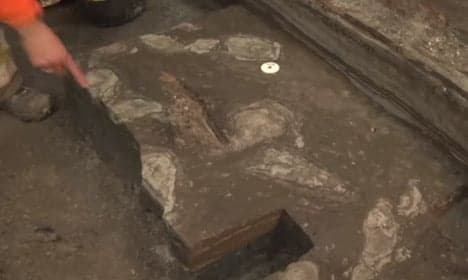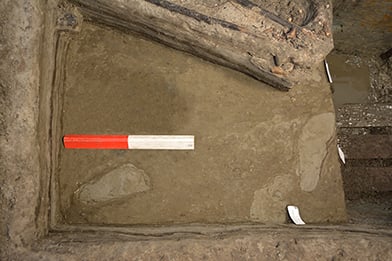5,000-year-old footprints found in Denmark

The discovery of footprints of Stone Age fisherman gives insight into their everyday life and their relation to the water.
Footprints dating back 5,000 years were uncovered during excavation work on the Fehmarn Belt Fixed Link, Museum Lolland-Foster announced. According to the museum, the footprints were made by Stone Age fisherman. “It is really exceptional to find human footprints. Normally we find rubbish in the form of tools and pottery, but now we have found a completely different trace of the past: the footprints of a human,” Tejre Stafseth, an archaeologist at Museum Lolland-Foster said in a press release. The museum said that this marks the first time that archaeologists have found ancient human footprints in Denmark. 
The footprints were easily visible in the dark underground environment. Photo: Museum Lolland-Foster The footprints were found next to a system of traps used to catch fish, and archaeologists believe that the tracks were made right before a huge storm swept in and covered the entire area with a layer of sand. The find indicates that at least two individuals attempted to salvage what they could of the fishing traps. “Studies have shown that Stone Age people repeatedly repaired and actually moved parts of the trap to make sure that it always worked and was optimally positioned in relation to the coast and the current. We can follow the footsteps and sense the importance of the trap, which was essential for the coastal populations' survival,” Stafseth said. Excavation for the Fixed Link is still ongoing, so archaeologists hope they might find more clues about the Stone Age fisherman and maybe even more footprints. The Fehmarn Belt Fixed Link will connect the Danish island of Lolland with the German island of Fehmarn. That project is expected to be completed in 2021 and will be the largest immersed tunnel in the world when finished. A short video of the historical find is below (in Danish):
Comments
See Also
Footprints dating back 5,000 years were uncovered during excavation work on the Fehmarn Belt Fixed Link, Museum Lolland-Foster announced.
According to the museum, the footprints were made by Stone Age fisherman.
“It is really exceptional to find human footprints. Normally we find rubbish in the form of tools and pottery, but now we have found a completely different trace of the past: the footprints of a human,” Tejre Stafseth, an archaeologist at Museum Lolland-Foster said in a press release.
The museum said that this marks the first time that archaeologists have found ancient human footprints in Denmark.

The footprints were easily visible in the dark underground environment. Photo: Museum Lolland-Foster
The footprints were found next to a system of traps used to catch fish, and archaeologists believe that the tracks were made right before a huge storm swept in and covered the entire area with a layer of sand.
The find indicates that at least two individuals attempted to salvage what they could of the fishing traps.
“Studies have shown that Stone Age people repeatedly repaired and actually moved parts of the trap to make sure that it always worked and was optimally positioned in relation to the coast and the current. We can follow the footsteps and sense the importance of the trap, which was essential for the coastal populations' survival,” Stafseth said.
Excavation for the Fixed Link is still ongoing, so archaeologists hope they might find more clues about the Stone Age fisherman and maybe even more footprints.
The Fehmarn Belt Fixed Link will connect the Danish island of Lolland with the German island of Fehmarn. That project is expected to be completed in 2021 and will be the largest immersed tunnel in the world when finished.
A short video of the historical find is below (in Danish):
Join the conversation in our comments section below. Share your own views and experience and if you have a question or suggestion for our journalists then email us at [email protected].
Please keep comments civil, constructive and on topic – and make sure to read our terms of use before getting involved.
Please log in here to leave a comment.